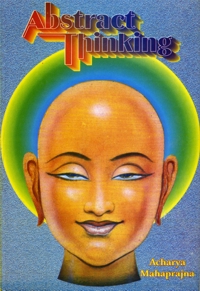
Dharmya dhyana is an important method of finding out the nature of reality. It is not a meditation on what is religious and what is not. It is a meditation on the characteristics and modes of truth. Through it are revealed the secrets of the substantial world. A lot of research is being done in the scientific world. It is dharmya dhyana, which underline all this research.
To discover is nothing evil. Research, whether undertaken by a scientist, a master of spirituality or a sadhak, is research after all. It is not 'arttadhyana' (concentration due to anger). The only thing is that along with this research runs the cycle of attachment and aversion.
Where there is the quest of pure truth, one is concerned only with the discovery of the essential fact, as for example, what is an atom? What is an electron? What is a proton? Neutron or nucleus? All this is an exploration of fact. This is dharmya dhyana. Similarly, to explore the problems created by the mind, to discover the efficacy of willpower - all these things the scientists are doing and all these investigations should have been undertaken by the spiritual practitioners. But they have displayed little interest in this field; they are indifferent. But the scientist is very alert and active about it. This is a great challenge to the world of spirituality. The scientist is accomplishing this work selflessly, without any feeling of attachment and aversion.
Whoever is engaged in the search for truth, finds it ultimately. Why should we not grant that a questioner after truth, whether he is a scientist or a sadhak, is a companion of spirituality in as much as he, freeing himself from attachment and aversion, is engaged in the search for truth? The sadhaks should grasp this secret and engage themselves in the search for truth.
How do we know whether dharmya-dhyana has descended upon an individual or not? Ancient sadhaks have laid down a criterion. When dharmya-dhyana descends upon a person, the essence of a situation is instantly revealed into him. The moment a problem comes up, its essential meaning is laid bare and a solution suggests itself. We know thereby that dharmya-dhyan has descended upon that person. In the course of discovering the substantial truth, many things spontaneously come to light. You find a leaf, and the whole mystery of it is revealed unto you. One sentence makes you grasp the whole story. Falling into step, basic common sense, highest intelligence - all these are the characteristics of the meditator of dharmya-dhyana. The realisation of dharmya-dhyana is much more an internal affair. The criterion for it is also internal. The individual himself comes to know if dharmya-dhyana is descending upon him. His conduct and character undergo a change. Goodwill awakens in him. Non- violence flowers and strong dedication to truth is realised in him. Non-stealing matures in him and there is freedom from passions and lust. There is avoidance of extremes and infatuation declines. These all constitute the internal criteria of dharmya-dhyana.
There are also certain external criteria. The body grows more and more stable. If the body becomes quiescent and immovable, the moment one sits down, it means that dharmya-dhyana has descended upon one. The descent of dharmya-dhyana also implies the ending of all intemperance of hand, foot and speech. These are the two external characteristics.
The third characteristic is - the slowness of breath. If the pace of breathing is fast, it means that one has not entered dharmya-dhyana. If the pace is slow, dharmya-dhyana has materialised. This is not only the criterion of Jain Acharyas, but also the test prescribed by hatha-yoga. Breathing becomes so slow that it is hardly perceivable. Thus, the mildness of breath, the stability of disposition and the absence of excitement in conduct are the criteria. Generally people reckon a sadhak by his behaviour. If the sadhak's behaviour is marked by anger and cunning, then dharmya-dhyana has not materialised in him. One must thoroughly assimilate this fact. The meditator's disposition should be tranquil and his conduct free from excitement.
Dharmya-dhyana is accomplished with the help of auspicious leshyas. Tejas ('red'), padma ('yellow') and shukla ('white') are the three auspicious leshyas. The more these leshyas are, the more concentrated is Dharmya-dhyana. In the absence of these leshyas, enter attachment and aversion. Dharma-dhyana remains dharma-dhyana no longer. The function of the red leshya is to make one experience bliss, it is the giver of joy - so joy giving that in the material world there is nothing to compare with it. The joy of the sadhak, who rightly practises red-leshya meditation for a year, goes far beyond the joys afforded by all the gods of universal goodness. Padma leshya manifests peace. Such deep tranquillity of mind, such pacification of passions as knows no limit. Shukla leshya manifests veetaragata and the purity of passions, mind and consciousness.
If a man is happy, and experiences bliss all the time, it means that he has realised dharma-dhyana in his life. If one's life is permeated by peace, we should take it that it is inspired by dharma-dhyana. If the heart is pure, if there is in it no deceit, no thuggery, if there is no exceptionable conduct, it points to the realisation of dharma- dhyana in one's life.
Dharma-dhyana requires faith, self-study, and the right attitude. This results from its fundamental characteristics and its anuprekshas.
Dharma-dhyana has four anuprekshas:
- Anupreksha of aloneness: "I am along!"
- Anupreksha of transitoriness: "All unions are transitory!"
- Anupreksha of insecurity: "There is no other refuge!"
- Anupreksha of mundaneness: "The transmigration of the soul!" The soul is roaming all over the world.
 Acharya Mahaprajna
Acharya Mahaprajna

